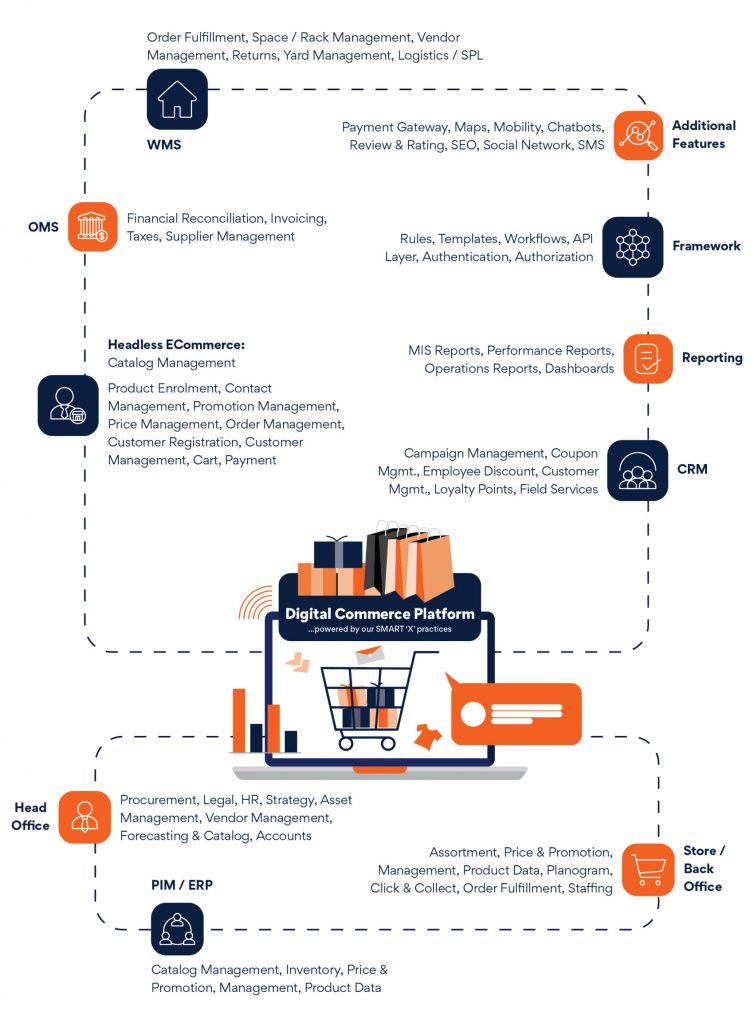In the rapidly evolving commerce landscape, the fusion of digital and unified commerce is ushering in a new era of seamless and personalized experiences for consumers, buyers, merchandisers, retail store owners, warehouse, and supply chain managers. This blog delves into the key aspects of this digital commerce ecosystem and explores how it is shaping the future of retail. Witness the evolution of commerce as we explore how this synergy empowers data-driven, personalized experiences for every key player in the value chain.

Unified Digital Commerce is the Future of Retail
As we step into the future, the concept of unified digital commerce stands tall as the linchpin of retail success. With retailers combining front- and back-end systems to deliver seamless connected experiences between digital and in-person interactions, the global unified commerce market is predicted to reach $23.47 billion by 2030. This underscores the pivotal role of digital platforms in facilitating transactions, fostering relationships, and streamlining the entire commerce journey to drive customer loyalty and revenue growth. Unified digital commerce isn’t just about enhancing the customer experience—it’s a game-changer for merchandisers too. By integrating data analytics tools into the commerce ecosystem, merchandisers gain invaluable insights into consumer behaviour, trends, and preferences. This data-driven approach enables more informed decisions regarding product assortments, pricing strategies, and promotional campaigns. The result is a more agile and responsive retail strategy that adapts to the ever-evolving market dynamics.
Blurring Lines between Online and Offline
The distinction between offline and online shopping experiences is gradually fading away. Consumers expect a seamless journey, effortlessly transitioning from browsing online to exploring products in-store. This convergence of channels is not just a trend; it’s a necessity as omnichannel consumers spend about 34% more than those who shop exclusively in stores, says McKinsey. Businesses that successfully blend online and offline experiences create a holistic shopping environment to drive revenue growth. Leveraging technologies like augmented reality (AR) adds an extra layer of engagement, making the entire process more immersive and enjoyable.
Data-Driven Personalized Journey Experiences
Today, customers interact with brands through various channels such as mobile apps, websites, physical stores, and more. They demand a seamless experience that transcends these touchpoints, regardless of how and where they shop. The key to a brand’s success is delivering seamless, personalized, and convenient shopping experiences by unifying all channels and data throughout the customer journey. Unified commerce consolidates critical data into a centralized platform so that retailers can have a single source of truth to deliver seamless and personalized experiences to boost conversion rates and customer loyalty. The integration of customer data across various touchpoints allows businesses to tailor their offerings, recommendations, and promotions to individual preferences.
In-Store Experiences with Unified Commerce
The physical retail space is not becoming obsolete; instead, it is evolving. Unified commerce extends its influence to in-store experiences, creating a symbiotic relationship between the digital and physical realms. Mobile devices, equipped with unified commerce capabilities, empower store associates to provide real-time information, personalized recommendations, and a frictionless checkout experience. Unified Commerce offers a range of new sales channels that cater to customer preferences. With the “buy online, return in-store” or “reserve online, try in-store” options, customers can experience seamless transitions between digital and physical retail spaces, making it easier for them to enjoy greater flexibility. This, in turn, enhances the overall customer experience and boosts sales for retailers.
Impact of Social Media
With 76% of social media users purchasing a product based on what they saw on social media, the collaboration between social media and retail players is set to create new investment opportunities for digital leaders. This partnership unlocks novel ways to reach and engage with consumers. Integrating commerce into social platforms extends the storefront to where customers already spend a significant amount of their time, creating a seamless transition from discovery to purchase. Businesses that actively seek and foster such partnerships position themselves at the forefront of innovation, gaining a competitive edge in the digital marketplace.
Navigating the Future with Generative AI
The fusion of digital and unified commerce is reshaping the commerce ecosystem, fostering seamless experiences, and driving personalization across the entire journey. Forrester says, in 2024, digital commerce will continue to witness significant changes as Generative AI will become more valuable for digital businesses. Customers will continue to demand seamless uninterrupted interactions at every step of their journey and expect hyper personalized experience across touchpoints. In the ever-evolving retail landscape, unified commerce is no longer a mere buzzword but a critical differentiator to stay ahead of the curve. It’s more than transactions, it’s a holistic approach, redefining the landscape of commerce for a future were connectivity and personalization reign supreme.
Author’s Profile
Padmanabhan Venkatesan
Senior Vice President & General Manager, Consumer Tech







